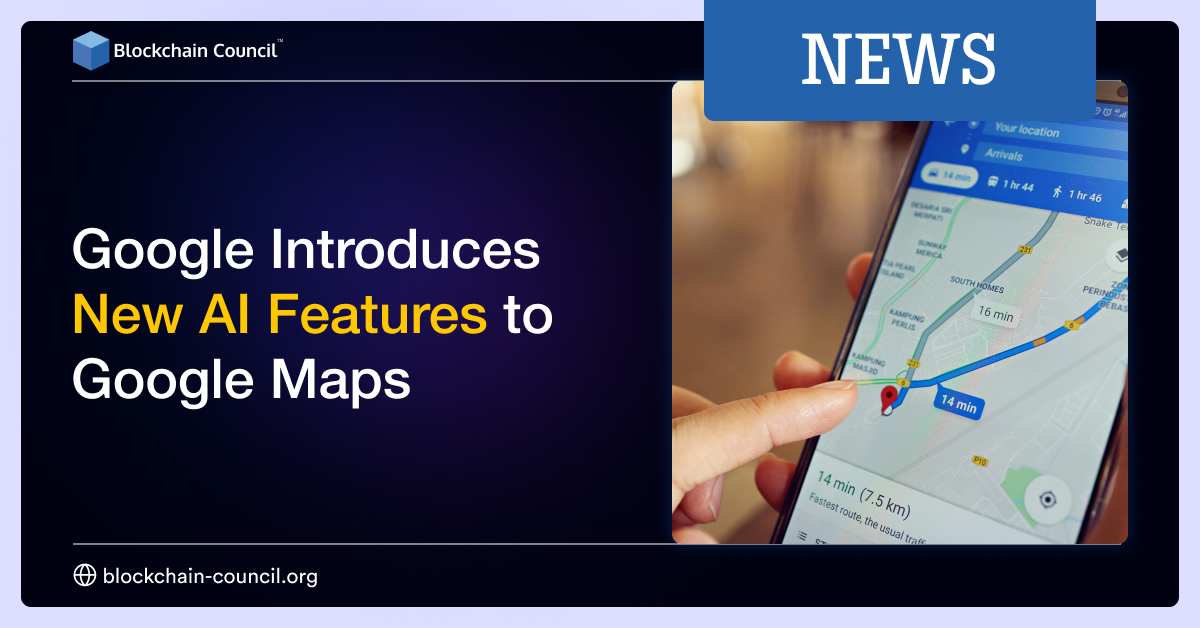
- Blockchain Council
- November 01, 2023
Google Maps has long been a trusted companion for travelers worldwide, offering guidance and insights to help us navigate our way through the vast expanse of the world. Over the years, Google has consistently worked on enhancing this navigation tool, making it even more valuable and user-friendly. The latest wave of updates to Google Maps is no exception, and it leverages the power of Artificial Intelligence (AI) to transform the way we plan trips, make eco-friendly choices, and discover new and exciting activities. These new AI-powered features are set to redefine how we explore and interact with the world around us.
One of the most visually advanced additions to Google Maps is the introduction of “Immersive View.” This feature promises to revolutionize the way users preview their journeys. By seamlessly blending billions of Street View and aerial images using advanced AI, Immersive View allows travelers to experience simulated journeys as if they were physically present. It’s not just a static preview; it’s an interactive experience. Users can explore their routes from various vantage points, zoom in for a closer look, pan around, and even manipulate the time of day and weather conditions. This immersive preview is designed to give users a vivid sense of what their journey will be like, enabling them to make informed decisions before setting out.
Also Read- Artificial Intelligence And Its Role In The Metaverse Growth
The technology behind Immersive View is truly remarkable. It leverages computer vision, artificial intelligence, and the vast repository of Street View and aerial images to generate highly detailed 3D representations of routes. This isn’t limited to routes alone; Immersive View was initially launched for individual landmarks and locations. Additionally, developers can now create their own immersive experiences using the new 3D mapping tools available in the Google Maps Platform.
The rollout of Immersive View for routes is already in progress, with cities like Amsterdam, Barcelona, Las Vegas, London, Los Angeles, New York, Paris, San Francisco, Seattle, and Tokyo among the first to benefit from this exciting feature. It’s available on both Android and iOS platforms, adding a new layer of engagement and personalization to the travel experience.
But Immersive View is just one part of Google’s AI-driven transformation of Maps. The Lens feature in Google Maps is also expanding its capabilities. Lens uses AI and augmented reality to provide real-time information about nearby restaurants, shops, transit stations, and more. Whether you’re in a new city and need to figure out which way to go after exiting a subway station or you’re exploring unfamiliar territory in search of a nearby coffee shop, Lens in Maps has you covered. It’s like having a virtual tour guide right on your smartphone.
This feature, initially introduced in a few cities, is now set to make its presence felt in over 50 more cities globally. It’s a testament to how Google Maps is becoming increasingly adept at helping users orient themselves in unfamiliar environments, thanks to the integration of AI and augmented reality.
For electric vehicle (EV) drivers, Google Maps is offering a helping hand in reducing “charging anxiety.” This concern, familiar to many EV users, stems from the uncertainty of finding charging stations on their routes. The latest updates in this regard are set to provide users with detailed and valuable information.
Also Read- What is the Metaverse? Step-by-Step Beginners Guide
When planning a trip, users can now see specifics about charging stations, such as compatibility with their vehicle, the number of chargers available, their type, power level, and even when they were last used. This information is invaluable, helping users avoid the frustration of reaching a charging station only to find it out of order or busy.
These updates are rolling out globally, further enhancing the appeal of Google Maps to the growing community of electric vehicle drivers. It’s a clear example of how AI can enhance our everyday experiences and reduce the challenges associated with newer technologies.
Google Maps is also reimagining search with AI-powered visual results. Users searching for specific activities, like “animal latte art,” will now be presented with photo results of matching locations. These thematic search results are generated through the analysis of billions of photos using advanced computer vision models. Users can tap through the photo results to explore further details, read reviews, get directions, and more about each location. This innovation relies on Google’s expertise in computer vision, image recognition, and artificial intelligence.
The new visual search experience is initially launching in France, Germany, Japan, the UK, and the US, and it promises to make searching for specific activities more engaging and informative. It’s yet another example of how AI can be harnessed to deliver a more personal and insightful user experience.
Google Maps, which has been a reliable companion for travelers for several years, is evolving into something more than just a navigation tool. It’s transforming into a travel companion that helps users explore, plan, and navigate with confidence. These AI-powered features are designed to make our travel experiences more immersive, informative, and sustainable. They connect us to the world in a way that’s engaging and personal, making every journey a unique adventure.





































































 Guides
Guides News
News Blockchain
Blockchain Cryptocurrency
& Digital Assets
Cryptocurrency
& Digital Assets Web3
Web3 Metaverse & NFTs
Metaverse & NFTs
